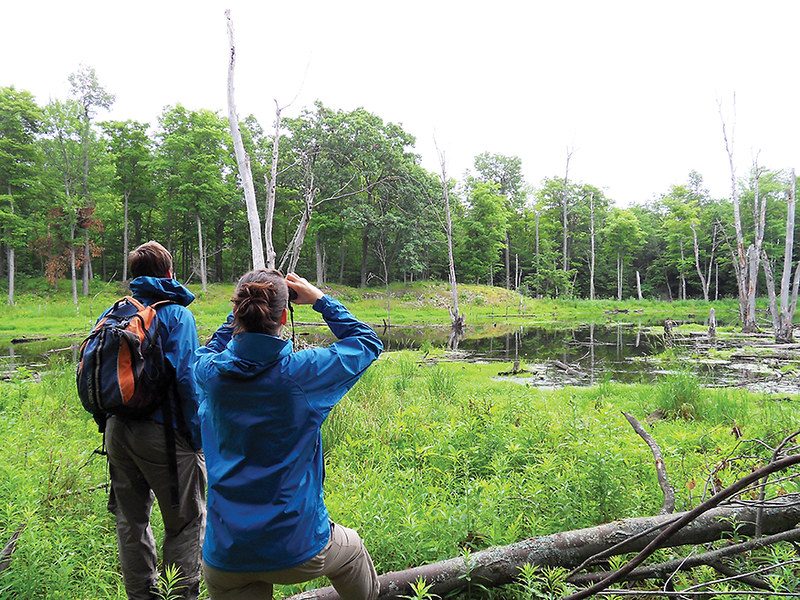Lost Bay's shoreline wetlands
About
Named for the eastern arm of Gananoque Lake, the Lost Bay Nature Reserve is 260 hectares (643 acres) in size. It is considered part of the Algonquin to Adirondack Connection (A2A) because it is located within the Frontenac Axis – the southernmost part of the Canadian Shield that forms the Thousand Islands.
These islands provide a bridge for plant and animal species to cross the St. Lawrence River, which enables wildlife to travel within the corridor between the two parks in response to environmental change, maintaining both population and genetic diversity.
Plants and Animals
The nature reserve is home to 24 species at risk, including Blanding’s, eastern musk, northern map and snapping turtles, all of which are struggling to hold their ground elsewhere in the province.
About three-quarters of the property is forested and the remainder consists predominantly of wetlands, which are provincially significant and home to important reptiles, birds and mammals. Ducks, especially wood ducks, are often seen foraging for food and sheltering in the marshes. The relatively undisturbed wetland areas, linked by natural corridors of forest, provide an excellent habitat for birds such as the red-shouldered hawk, great blue heron and osprey. Songbirds, such as black-capped chickadees and yellow warblers, nest in the tall maples nearby.
As one of the few mature stands in the area, the nature reserve’s hemlock forests also shelter a number of deer, which take shelter from the elements and give birth to their fawns.
Bridging the Gap
In 2014, thanks to the generous support of Ontario Nature’s wonderful members, our Lost Bay Nature Reserve has grown. We were presented with an opportunity that was too good to pass up. A nature-loving couple offered to sell us their 40-hectare property located between our Lost Bay Nature Reserve’s two separate parcels of land. Having cared for the property’s wildlife and natural habitats for 25 years, they wanted to make sure that Ontario Nature had the opportunity to add it to the adjacent nature reserve.
With little time to act, we reached out to our members for help in securing the property and putting long-term stewardship funds in place. The response was overwhelming, and our hope for one continuous block of protected habitat is now a reality.
The newest piece of Lost Bay is a biodiversity hotspot consisting of mature, intact forests and provincially significant wetlands. It bridges the gap between 103 protected hectares on the west and 95 hectares on the east, creating a connected 238-hectare nature reserve.
History
In October of 2000, the dream of linking the woods and wetlands of Ontario’s Algonquin Park to New York State’s Adirondack Mountains became a step closer to reality. Local landowners saw an opportunity to protect 44 hectares of provincially significant wetlands and mature forest around Lake Gananoque, and with the generous help of local donors, the Nature Conservancy of Canada acquired the Lost Bay Nature Reserve. Shortly afterwards, the nature reserve was turned over to Ontario Nature.
In fall of 2009, an additional 59 hectares of provincially significant wetlands and mature forest was purchased and added to the nature reserve, again with the generous help of local donors. In 2011, another 95.1 hectares were added to the nature reserve. This property is named the Summerfield Tract in memory of Debra Summerfield whose family made a generous contribution in her name.
Stewardship
The Lost Bay Nature Reserve is currently stewarded by dedicated local landowners.
We are looking for additional stewards to join Lost Bay Nature Reserve’s stewardship team. To learn more, please visit our Volunteer as a Steward webpage.
Visiting
Direct access to Lost Bay Nature Reserve is limited due to a lack of parking. We recommend visitors to view the property’s beautiful shoreline by boat, kayak or canoe from Lost Bay. We also encourage prospective visitors to reach out to the nature reserves team for information about property access.
If you have any questions, please contact us at 416-444-8419.
We do not charge a fee for entrance and there are no operating hours on any of our nature reserves. Properties are monitored by volunteer stewards. We rely on visitors to be safe, minimize their impact on nature and be respectful of others. For more information about visiting the nature reserves, please read our Permitted Activities Policy.






